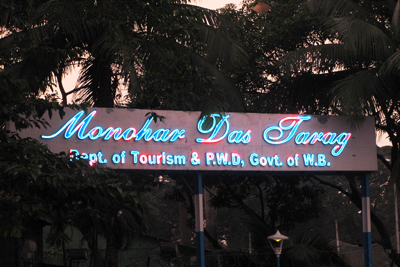
In Bengali language, the word ‘Tarag’ stands for a lake or a tank or a deep water body, which is equivalent to Talao in Hindi. During their rule, the British dug up or renovated numerous tanks in the city of Calcutta, mainly for the purpose of drinking water. Apart from the Laldighi or Dalhousie Square (subsequently rename BBD Bag), most of the tanks were later filled up to build parks like, the Curzon Park, Allen Park, Shradhananda Park and many more. However, the Manohardas Tarag, located almost opposite Lindsay Street, was neither dug up by the British nor dredged up for the purpose of public usage.


Born in Varanasi in 1727, Manohar Das Shah was the son of Gopal Das Shah, a prominent member of the aristocratic Shah family of Varanasi. Manohar Das moved to Calcutta in 1780 for business purpose and finally settled in the city.
In or around 1800, he arranged to dig up the tank, with the noble intention to provide drinking water for the cows and also purchased 100 bighas of land around the tank for pasturage. Apart from that, he erected four small temples at the four corners of the tank and placed one deity in each of them, like a Shiva-Linga, a Vishnu image, a Devi image, and an image of Surya, the Sun god. Ever since the day, the tank has been called after him. Much later, the tank was handed over to the perpetual trust of the municipal authorities.


There is a marble plaque by the eastern side of the tank, set up by the sons and grandsons of Manohar Das Shah's fifth descendant Madhab Das and was unveiled by Dr. Kailash Nath Katju, the then governor of West Bengal, on 12th October 1948, on the auspicious day of Bijoya Dashami.
Manohar Das also constructed a market building in the city, which is today known as the Manohardas Katra. The street that runs to the east of the market building was subsequently named after him.
Since the 1980s, with the removal of the tram tracks and the beginning of the constructional work for Metro service, Manohar Das Tarag remained neglected for quite a long time. Gradually, the marble plaque became partially shrouded by wild creepers. The fencing almost disappeared and the tank became a jungle of thermocol (Polystyrene) and used plastic bags. The temples at the corners became temporary shelters for the beggars, anti socials and the stray dogs. In fact, the entire pavement along the tank was turned into a filthy toilet with intolerable foul smell.


However, recently the tank was renovated and was decorated with five floating fountains, which work from 4pm in the afternoon. The entire place has been converted into a beautiful refreshing park. The octagonal structures, each with a dome on the top, at the corners of the tank are also renovated and painted. However they are devoid of any image or idol, which are missing, probably since the British period.
